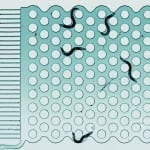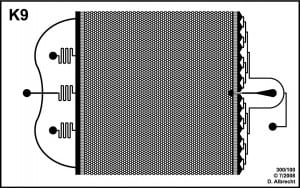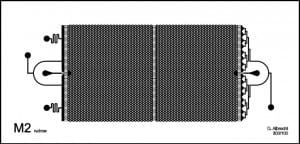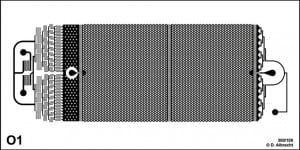Microfluidics
 Microfluidics enables the observation of neural activity and behavior elicited by chemical stimuli in precise and repeatable patterns, both in space and time. This environmental reproducibility is critical for the study of behavior, which is inherently a variable, often stochastic process.We design and fabricate microfluidic systems in-house at the WPI BioMedical Engineering-MicroFabrication Laboratory (BME-MFL) located at Gateway Park.If you are interested in developing, using, or purchasing microfluidic devices or accessories, please contact us. We are in preparation to offer devices or molds for purchase in a standard library design or, for additional costs, custom designs.
Microfluidics enables the observation of neural activity and behavior elicited by chemical stimuli in precise and repeatable patterns, both in space and time. This environmental reproducibility is critical for the study of behavior, which is inherently a variable, often stochastic process.We design and fabricate microfluidic systems in-house at the WPI BioMedical Engineering-MicroFabrication Laboratory (BME-MFL) located at Gateway Park.If you are interested in developing, using, or purchasing microfluidic devices or accessories, please contact us. We are in preparation to offer devices or molds for purchase in a standard library design or, for additional costs, custom designs.
Current designs (available soon):
| Name | Design | Reference |
| Blank template 20x20mm | <image> | |
| Worm trap for neural imaging | |
Chronis, 2007 |
| Behavior, single arena / 22mm, 2-stripes (K9) |  |
Albrecht, 2011 |
| Behavior, dual arena / 16mm, 1-stripe (M2) |  |
Albrecht, 2011 |
| Behavior, dual arena / 16mm, symmetric gradient (O1) |  |
|
| Neural imaging and behavior, single arena, pulse (P2) |  |
Larsch, 2013 |
Photomask design
To obtain photomasks for photolithography, 2D line drawings are first prepared using CAD software. We prefer DraftSight software, a free* software package for students and individuals that is compact (runs on an old laptop), and uses the same syntax as more sophisticated software such as AutoCAD and SolidWorks.
*activation with a valid email address is required.
A tutorial how to draw CAD photomasks is available here: Photomask Design v2.pdf.
Video tutorials for Draftsight are available: